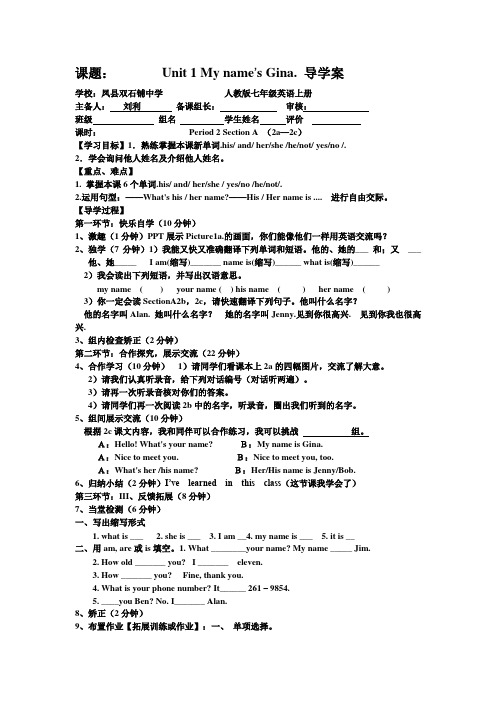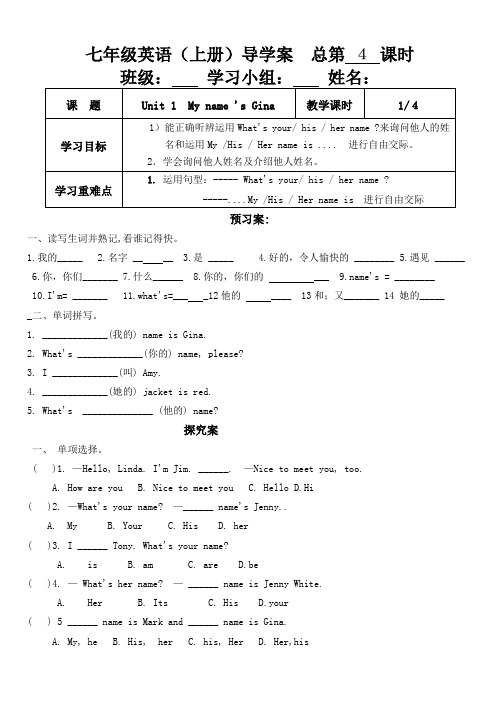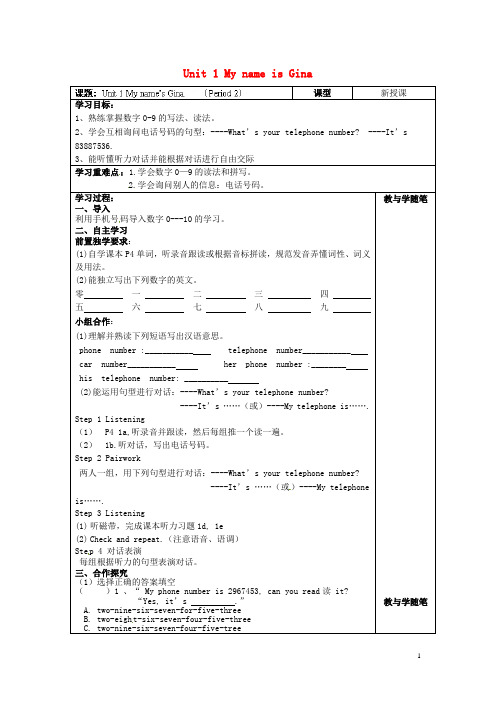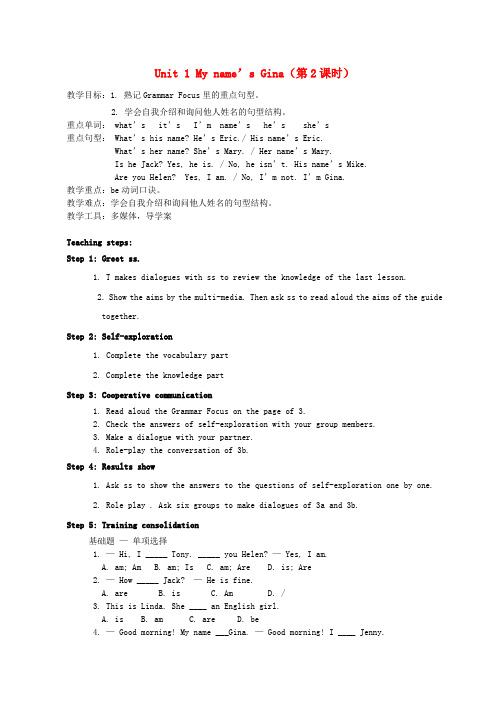七年级英语上册《Unit 1 My name 's Gina(第1课时)Section A 1a-2c》导学案(新版)人教新目标版
- 格式:doc
- 大小:91.00 KB
- 文档页数:2

课题:Unit 1 My name’s Gina. 导学案学校:凤县双石铺中学人教版七年级英语上册主备人:刘利备课组长:审核:班级组名学生姓名评价课时:Period 2 Section A (2a—2c)【学习目标】1.熟练掌握本课新单词.his/ and/ her/she /he/not/ yes/no /.2.学会询问他人姓名及介绍他人姓名。
【重点、难点】1. 掌握本课6个单词.his/ and/ her/she / yes/no /he/not/.2.运用句型:——What's his / her name?——His / Her name is .... 进行自由交际。
【导学过程】第一环节:快乐自学(10分钟)1、激趣(1分钟)PPT展示Picture1a.的画面,你们能像他们一样用英语交流吗?2、独学(7分钟)1)我能又快又准确翻译下列单词和短语。
他的、她的___ 和;又___他、她_____ I am(缩写)_______ name is(缩写)______ what is(缩写)______2)我会读出下列短语,并写出汉语意思。
my name ( ) your name ( ) his name ( ) her name ( )3)你一定会读SectionA2b,2c,请快速翻译下列句子。
他叫什么名字?他的名字叫Alan. 她叫什么名字?她的名字叫Jenny.见到你很高兴. 见到你我也很高兴.3、组内检查矫正(2分钟)第二环节:合作探究,展示交流(22分钟)4、合作学习(10分钟)1)请同学们看课本上2a的四幅图片,交流了解大意。
2)请我们认真听录音,给下列对话编号(对话听两遍)。
3)请再一次听录音核对你们的答案。
4)请同学们再一次阅读2b中的名字,听录音,圈出我们听到的名字。
5、组间展示交流(10分钟)根据2c课文内容,我和同伴可以合作练习,我可以挑战组。
A:Hello! What's your name? B:My name is Gina.A:Nice to meet you. B:Nice to meet you, too.A:What's her /his name? B:Her/His name is Jenny/Bob.6、归纳小结(2分钟)I’ve learned in this class(这节课我学会了)第三环节:III、反馈拓展(8分钟)7、当堂检测(6分钟)一、写出缩写形式1. what is ___2. she is ___3. I am __4. my name is ___5. it is __二、用am, are或 is填空。

人教新目标英语七年级上册导学案课型:New(1) 课题:Unit 1 My name's Gina. Section A:(1a—1c)一、教学目标: 掌握介绍自己和问候他人的句型:What’s your name?My name’s Gina.Nice to meet you! Nice to meet you, too.二.教学重难点:1. 如何询问别人的姓名及向别人作自我介绍。
2.my 与I 的区别。
三.课前预习练习:(一).写出所缺的字母:1. n i __ e2. wh __ t3. y __ u r4. na __ e5. h __ l __ o6. c __ p7. j __ __ k __ t8. r __ l __ r9. o __ __ n __ e 10. k __ y(二). 翻译:1.我的_________ 2. 名字_________ 3. 你们的___________ 4. 遇见_________ 5. 令人愉快的__________ 6. 什么__________ 7. 我___________ 8.你的名字_______________9. 你的名字叫什么?_________________________10. 我的名字叫辛蒂。
_________________________11.见到你很高兴。
___________________________12. 你好,我是戴尔。
_________________________四.课堂合作与研讨:1.根据要求完成1a.2.听录音独立完成1b.3.根据要求完成1c.五.归纳总结1.my 与I 的区别:my 意为“我的”,是形容词性的物主代词,在句子中充当定语,修饰名词;I意为“我”,是主格代词,在句中充当主语,其后面的be动词用am.如:I am a boy. My name is Bob. 我是一个男孩,我的名字叫鲍勃。

七年级英语(上册)导学案总第4课时预习案:一、读写生词并熟记,看谁记得快。
1.我的_____2.名字 __ __3.是 _____4.好的,令人愉快的 ________5.遇见 ______6.你,你们_______7.什么______8.你的,你们的 ___'s = ________10.I'm= _______ 11.what's=___ _12他的 ____ 13和;又_______ 14 她的______二、单词拼写。
1. _____________(我的) name is Gina.2. What's _____________(你的) name, please?3. I _____________(叫) Amy.4. _____________(她的) jacket is red.5. What's ______________ (他的) name?探究案一、单项选择。
( )1. —Hello, Linda. I'm Jim. ______. —Nice to meet you, too.A. How are youB. Nice to meet youC. HelloD.Hi( )2. —What's your name? —______ name's Jenny..A. MyB. YourC. HisD. her( )3. I ______ Tony. What's your name?A. isB. amC. areD.be( )4. — What's her name? — ______ name is Jenny White.A. HerB. ItsC. HisD.your( ) 5 ______ name is Mark and ______ name is Gina.A. My, heB. His, herC. his, HerD. Her,his( )6.She is a student and ()name is Kate.A.SheB.herC.hers二、用所给词的适当形式填空。

Unit1 My name is Gina.Language goals:In this unit students learn to introduce themselves, greet people and ask for and give telephone number.New languages:What’s your name? My name is /I’m …Hello! I’m … /Hi! I’m …Nice to meet you!What’s his name? His name is …What’s her name? Her name is …What’s her family name?What’s her first name?What’s your phone number?Difficult points:1. How to introduce yourself and greet people in the right way.2. I mprove the students’ reading, listening, speaking and writing skills.3. The difference between Chinese names and English names.Teaching aids:puter, recorder, colorful chalkTeaching periods:Period 1: Section A 1a /1b /1c /2a /2b /2c/ Grammar FocusPeriod 2: Section A 3a /3b /4Period 3: Section B 1a /1b /2a /2b /2cPeriod 4: Section B 3a /3b /3c /4 / Self checkPeriod 1Teaching aims:1. Memorize the words on page1and page2.2. Learn the target languages:My name is Gina.What’s your name?Hello! I’m Mary.Hi! I’m Jim.What’s his name?What’s her name?3. Train the listening and speaking skills.Teaching procedure:Step 1 Free talkLet students talk in pairs using the sentences they’ve learned in Starter or ask some questions in Starter, have students answer them. For example: Good morning/afternoon/evening!How are you?What’s this in English?What color is it?Step 2 Section A 1aThis activity tests students’ vocabulary.1. Draw student’s attention to the pictures. Point to an object in it andask what it is. Say, now look at the picturesand write down as many words as you can2. Ask two students to write the words on the blackboard.3. Check the students’ answers. Ask some students to call out their wordsand spell them. Write down the words on the board.Step3 Section A 1bThis activity gives students practice in understanding the target language in spoken conversation.Read the instruction to the students. Make sure the students understand how to do it. Say, now listen and number the conversations 1-3.(1) Play the recording for the first time. Students only listen.(2) Play the recording a second time. Students number the conversations.(3) Check the answers together.Step 4 Section A 1cThis activity provides guided oral practice using the target language.(1) Ask three pairs to read the conversations in 1b. If necessary, ask studentsto repeat the names after the teacher.(2) Have students work in pairs to practice the conversations.(3) Say, Now use your own names when you have conversations .Move around theroom monitoring their work. Offer language or pronunciation support asneeded.(4) Let several pairs e to the front of the class and act out theirconversations.Step 5 Section A 2aThis activity gives students practice in understanding the key words and target languages.1. Point to a boy and a girl. Say, His name is---, her name is--- Have studentsunderstand the meaning of his and her.2. Read the instruction to the students.3. Play the recording for the first time. Students only listen.4. Play the recording a second time. Students number the pictures 1-4.5. Check the answers.Step 6Section A 2bThis activity provides listening practice.(1) Have one student read the names in the box.(2) Say, listen to the four conversations again.This time circle the names you hear.(3) Students listen and circle the names.(4) Check the answers.Step 7 Section A 2cThis activity provides guided oral practice using the target language.(1) Call attention to the two conversations in the box.Ask one pair to act out the first one. Tell them to use their own names.Ask another pair to act out the second one.Have them point to a boy or a girl when they ask the questions:What’s his name/What’s her name?(2) Let students work in pairs to practice the two conversations. As studentswork, move around the classroom, monitoring the conversations andoffering assistance if necessary.(3) Have several pairs of students present their conversations to the class. Step 8Grammar Focus(1) Divide the class into two groups to say the questions and responses.(2) Write down the full forms and contractions of the words on the right.Have students pare them. Then ask them to say the sentences in two ways. Step 9 Conclusion(1) Learn the words and phrases.(2) Master the target languages:My name is Gina.What’s your name?Hello! I’m Mary.Hi! I’m Jim.What’s his name?What’s her name?Step 10 Homework(1) Learn the words by heart.(2) Practice the conversations in 1b and Grammar Focus.(3) Do some preparing.Period 2Teaching aims:1. Memorize the words and phrases: first, first name, last, last name, boy, girl2. Learn about first name and last name.3. Train writing and speaking skills.Teaching procedure:Step 1 Revision1. Go over the words in last class. (Play a game. Divide the class into twogroups: boys and girls. Give them three minutes to read and write the words.Then look at the Chinese meaning on the cards. See which group can say andspell the words more quickly and correctly. )2. Ask students to make conversations about introduction and greeting. Step 2 SectionA 3aThis activity introduces the western concept of first name and last name.1. Write down a Chinese name and an English name on the board. For example:Deng Yaping and Jim Smith.2. Ask students to discuss the names. Encourage them to tell the differencebetween them. (English names are listed with the given name first and thefamily name or surname second. While Chinese names are listed with thefamily name first and given name second.)3. Ask some students to say their family names and first names.4. Have two students read the list of names in the box. Say, Guess, whichnames are first names and which are last names?5. Ask students to write F for first name and L for last name next to thewords. Students do the exercise by themselves.6. Check the answers.Step3 Work in pairs(1) Call attention to the picture on the right. Students look at the pictureand the sentences carefully. Have them pay attention to what the teacherwrites.(2) Have two students read the conversations in the picture aloud.(3) Ask students to work in pairs.Ask and answer about their first names and last names.Step4 SectionA 3bThis activity provides guided oral practice using the target language.(1) Point to the names in 3a.( You can write more names on the board.)(2) Say, Which names would you like to choose as your first name and lastname? Now choose your names.(3) Have students take turns to ask and answer the questions (using theirnew names):What’s your first name?What’s your last name?Students make a list of names.Then exchange their lists to correct any mistake they make.Step5 SectionA 4 (Game)This activity gives students an opportunity to practice target language in an interesting way.1. Demonstrate the game with three students.2. Say, Now in groups of four, play the game. As they work, move around theclassroom making sure students understand the procedure and correcting anymistake.3. Ask two groups to present their games to the class.Step 6 Conclusion(1) Learn the words and phrases in this class.(2) Grasp the target languages:What’s your first name?What’s your last name?Step 7 Homework(1) Memorize the words and phrases.(2) Make a conversation about asking for first name and last name.(3) Prepare next lesson.Period 3Teaching aims:1. Memorize the words on page4.2. Target languages:What’s your phone number?It’s …3. Train the listening and speaking skills.Teaching procedure:Step 1 Free talkLet students work in pairs. Make conversations using the target languages they’ve learned. For example:What’s your name? My name is …What’s his name? His name is …What’s her name? Her name is …What’s your first name?What’s your last name?Step 2 Section B 1aThis activity learns the numbers from 0 to nine.(1) Write the numbers 0-9 on the board. Ask who can say them in English.Encourage more students to read them.(2) Play the recording for the first time. Students only listen.(3) Play the recording a second time. Have students repeat the numbers.(4) Give students two or three minutes to read and write the mummers. Thenhave some students say them quickly and ask if anybody can spell them.Cheer for the students who do best.Step3 Section B 1bThis activity gives students practice recognizing the numbers 0-9 in spoken telephone numbers.Say, Now listen to the conversation, and write down the telephone number you hear.(1) Play the recording for the first time. Students only listen.(2) Play the recording a second time.Have students write the numbers in the blank.(3)Check the answers.(4) Work in pairs and practice the conversation.Step 4 Section B 1cThis activity gives students speaking practice using the target language.(1) Call attention to the conversation on the right. Have two students read it.(2) Practice the conversation in pairs.(3) Say,Now in groups of three or four, make up conversations using any phonenumber you like .As they work, move around the room monitoring their work.Offer language or pronunciation support as needed.(4) Let several pairs e to the front of the class to perform theirconversations for the class.Step 5 Section B 2aThis activity provides listening practice with the target language.1. Call attention to the names and the numbers in the box.2. Read each one to the class or ask some students to read them.3. Point to the blanks in the four telephone numbers. Say, The phone numbersaren’t finished. You need to write the last two numbers later. Now listenand match the names with the telephone numbers.4. Play the recording for the first time. Students only listen.5. Play the recording a second time Students write the letter of the person’stelephone number in the space after that person’s name.6. Check the answers.Step 6Section B 2bThis activity gives students practice recognizing the spoken numbers 0-9. (1) Say, Now let’s listen to the conversations again and finish each telephonenumber.(2) Students listen and fill in the missing numbers.(3) Check the answers.(4) If have time, have students repeat the telephone number after the recording.(5) Practice the four conversations in pairs.Step 7 Section B 2cThis activity provides guided oral practice using the target language.(1) Call attention to the address book. Ask one student,“What’s your phone number?” Write his/her name and phone number inthe address book.Make sure all the students understand how to fill in the address book.(2) Say, Now ask your four classmates their phone numbers and fill in theform.Step 8 Conclusion(1) Learn the numbers 0-9.(2) How to asking for phone number:What’s your phone number?It’s …Step 9 Homework(1) Remember the numbers from 0 to 9.(2) Make two conversations.(3) Do some preparing.Period 4Teaching aims:1. Memorize the words and phrases on page2. How to ask for first names/last names/phone numbers.3. Train speaking and writing skills.Teaching procedure:Step 1 Revision1. Go over the numbers in last class.Ask the students to read and spell numbers from 0-9.2. Talk about phone numbers.Step 2 Section B 3aThis activity reviews about first name and last name.1. Say, Look at the picture. How many cards can you see?Can you read the names on the card?2. Ask four students to read the names on each card. Then say,“Which is first name and which is last name? Do you know?”3. Point out the blank line following each first name in the exercise.Say, Write each person’s last name in the blank after the first name.4. Students finish the exercise individually.5. Check the answers.Step 3 Section B 3b & 3cThis activity provides speaking and writing practice using the target language.(1) Point to the ID card. Say, Look at the girl on the card. What’s hertelephone number? What’s her family name? What’s her first name?(2) Have students work in pairs and answer the three questions.(3) Check the answers.(4) Say, Look at the ID card in 3c. This is your card. Write your own firstname, last name, and telephone number on it.(5) As students work, move around the room checking progress.Step 4 Section B 4This activity gives students an opportunity to practice target language ina game.Read the instruction to the class. Make sure all the students know how to do it. Move around the room monitoring their work. Offer language or pronunciation support as needed.。


Unit 1 My name’s Gina(第2课时)教学目标:1. 熟记Grammar Focus里的重点句型。
2. 学会自我介绍和询问他人姓名的句型结构。
重点单词: what’s it’s I’m name’s he’s she’s重点句型:What’s his name? He’s Eric./ His name’s Eric.What’s her name? She’s Mary. / Her name’s Mary.Is he Jack? Yes, he is. / No, he isn’t. His name’s Mike.Are you Helen? Yes, I am. / No, I’m not. I’m Gina.教学重点:be动词口诀。
教学难点:学会自我介绍和询问他人姓名的句型结构。
教学工具:多媒体,导学案Teaching steps:Step 1: Greet ss.1. T makes dialogues with ss to review the knowledge of the last lesson.2. Show the aims by the multi-media. Then ask ss to read aloud the aims of the guide together.Step 2: Self-exploration1. Complete the vocabulary part2. Complete the knowledge partStep 3: Cooperative communication1. Read aloud the Grammar Focus on the page of 3.2. Check the answers of self-exploration with your group members.3. Make a dialogue with your partner.4. Role-play the conversation of 3b.Step 4: Results show1. Ask ss to show the answers to the questions of self-exploration one by one.2. Role play . Ask six groups to make dialogues of 3a and 3b.Step 5: Training consolidation基础题—单项选择1. — Hi, I _____ Tony. _____ you Helen? — Yes, I am.A. am; AmB. am; IsC. am; AreD. is; Are2. — How _____ Jack? — He is fine.A. areB. isC. AmD. /3. This is Linda. She ____ an English girl.A. isB. amC. areD. be4. — Good morning! My name ___Gina. — Good morning! I ____ Jenny.A. is; isB. am; amC. is; amD. am; is5. — Excuse me! _____ you Mr Wang? — Yes, my name ___ Wang Dongdong.A. Is; isB. Are; areC. Are; isD. Is; are拓展题——按要求完成下列各题。
Unit 1 My name's Gina.Section A (1a—2c)Ⅰ.根据句意及首字母提示补全单词1.Nice to m________ you.2.The boy's n________ is Nick.3.I a________ Amy.4.What's this in E________?5.How a________ you?Ⅱ.用be动词的适当形式填空1.—I ________ Bob. ________ you Eric?—Yes. My name ________ Eric.2.—What ________ her name?—Her name ________ Alice.3.—What ________ his name? ________ he Jack?—No. He ________ Mike.Ⅲ.选词填空I, my, you, your, he, his, her 1.—Is this her key?—No.________ key is black.2.—Is ________ Tom?—No. His name is Dale. This is ________ CD.3.—Are ________ Cindy? Is this ________ jacket?—Yes, ________ am. This is ________ jacket. Thank you. Ⅳ.从(B)栏中选出与(A)栏中的句子相对应的答语(A)( )1.Hello, Bob!( )2.What's your name?( )3.Nice to meet you.( )4.What color is that clock?( )5.What's her name?( )6.Are you Tom?( )7.How are you?(B)A.My name is Kate.B.Her name is Mary Brown.C.Nice to meet you, too.D.It's red.E.Hi, Lisa!F.I'm OK.G.Yes, I am.Ⅴ.选词填空1.—How are you?—I'm fine, thank you. And you?—I'm fine, ________(to, too).2.—________(What's, How's) your name, please?—My name is Jim.3.________(Her, She) name is Cindy Smith.4.—What's ________(you, your) name?—My name is Gina.5.—________(What's, What) is his name?—Eric.Ⅵ.按要求完成下列各题1. My name is Linda.(改为同义句)________ Linda.2. Her name is Kate__Green.(对画线部分提问)________ her name?3. The ruler is white.(对画线部分提问)________ ________ is the ruler?4. Kate is my name.(对画线部分提问)________ is ________ name?5. your, name, is, what (连词成句)________________________________________________________________________? Ⅶ.补全对话(A)Jenny: Hello, Mary!Mary: Hi, Jenny! 1.________Jenny: I'm fine, thank you. And you?Mary: 2.________(B)Jim: Hi, I'm Jim. 3.________Alan: My name is Alan.Jim: Nice to meet you, Alan.Alan: 4.________(C) Tony: Good morning!Linda: 5.________ I'm Linda. What's your name? Tony: I'm Tony Green.A.What's your name?B.I'm fine, too.C.How are you?D.Nice to meet you, too.E.Good morning!详解详析Ⅰ.1.meet 3.am 4.English5.areⅡ.1. a m; Are; is 2. is; is 3. is; Is; is Ⅲ.1. Her 2. he; his 3. you; your; I; my Ⅳ.1—5 EACDB 6—7 GFⅤ.1.too 2.What's 3.Her 4.your5.WhatⅥ.1.I'm 2.What's 3.What color 4.What; your 5.What is your nameⅦ.1—5 CBADE。
Unit 1 My name’s Gina.Section B 1a—2c教学设计一、教学目标1. 能掌握以下单词和短语:zero—nine, telephone, number, phone, first name, last name, friend, middle school, China等。
2. 能掌握以下句型:(1) —What’s your/his/her telephone number?—It’s …(2) —What’s your first/last name?—My first/last name is …(3) —What’s his/her first/last name?—His / Her first/last name is …3. 能辨别英文中的姓氏与名字,了解中英文中姓名之间的区别。
4. 能听懂日常对话,并且能够从听力训练中获取常见人名和电话号码的信息。
5. 能读懂介绍个人信息的文章,并且能够按要求提取关键信息。
6. 帮助学生比较中英文姓名的不同之处,通过了解中英文名字的区别,培养和提高学生对中外文化差异的敏感性和鉴别能力,加深对本国文化的理解和认识,培养学生的世界观意识,以及初步的跨文化交际能力。
二、教学重点及难点重点:1. 能掌握以下单词和短语:zero—nine, telephone, number, phone, first name, last name, friend, middle school, China等。
2. 能掌握以下句型:(1) —What’s your/his/her telephone number?—It’s …(2) —What’s your first/last name?—My first/last name is …(3) —What’s his/her first/last name?—His / Her first/last name is …3. 能辨别英文中的姓氏与名字,了解中英文中姓名之间的区别。
1
《Unit 1 My name 's Gina(第1课时)Section A 1a-2c》
导学案
【学习目标】:1、熟悉掌握词汇name clock 等
2、学会介绍自己并询问他人姓名,能够利用所学知识进行打招呼.
3、能听懂听力对话并能对根据听力对话进行自由交际.
【学习重点】: 使学生学会打招呼和介绍自己,并询问他人姓名的句型.
Nice to meet you . What's your name ? My name is ......
【学习过程】:
一、自主学习(教师寄语:Knowledge is power.)
学习任务一: 熟悉掌握词汇name ,clock
1、 认真观察第一页的图画,小组讨论你所认识的物品的英语单词.
2,、试着写出含有的物品的英语单词.
3、小组竞赛,展示( 看谁总结的多, 写的准确)
学习任务二: 学会介绍自己并询问他人姓名,能够利用所学知识进行打招呼.
1、 教师自我介绍,引导学生介绍自己.
A: Hello , I am Gina , What's your name ?
B: My name is Alan .
2、小组竞赛, 两人一组,询问他人姓名,介绍自己.
3,、分角色朗读1A对话.
学习任务三: 能听懂听力对话并能对根据听力对话进行自由交际.
1,、听录音, 给1B 的对话编号.
2、根据听力对话进行自由交际.
3、小组竞赛, 展示对话交际。
二、合作共建(教师寄语:Many hands make light work. )
小组讨论我们所学的英语名字和汉语名字的区别, 如何用英语拼写
你的名字?
三、系统总结(教师寄语:No man can do two things at once.)
1,、归纳你所学到的问候语.
2、自己编写一个打招呼并询问姓名的小对话.
四、诊断评价
(一) 单项选择.
4. ______name is Li lei .
2
A. I B. I am C. My D. you
5.— _______, What's your name ?
— John Green .
A. Hi B. Ok C. sorry D. Excuse me
(二) 写出下列单词的完全形式, 并写出汉语意思.
I'm _________ __________ what's __________ ________
name 's ___________ __________
(三)写出下列单词.
时钟 _______ 我的 ________ 你的___________ 名字_______ 遇见_________
(四)尝试翻译下列句子.
1. 见到你很高兴. _________________________________.
2.我叫王小雨. ____________________________________.
3. 你叫什么名字? ____________________________________
(五) 根据情景补全对话.
A: Good afternoon !
B: ____________________!
A; I ______Lucy . _________your name ?
B: My ______ is Jim . Nice to ______you !
A: _______________________________.
五、【课后反思】(教师寄语:Never do things by halves)